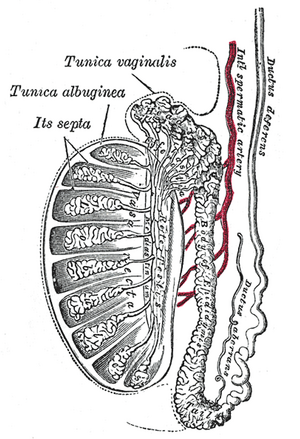Vas deferens
| Vas deferens | |
|---|---|

Male Anatomy
|
|

Vertical section of the testis, to show the arrangement of the ducts.
|
|
| Details | |
| Precursor | Wolffian duct |
| Artery | Superior vesical artery, artery of the ductus deferens |
| Lymph | External iliac lymph nodes, internal iliac lymph nodes |
| Identifiers | |
| Latin | Vas deferens (plural: vasa deferentia), Ductus deferens (plural: ductus deferentes) |
| MeSH | A05.360.444.930 |
| FMA | 19234 |
|
Anatomical terminology
[]
|
|
The vas deferens (Latin: "carrying-away vessel"; plural: vasa deferentia), also called ductus deferens (Latin: "carrying-away duct"; plural: ductus deferentes), is part of the male reproductive system of many vertebrates; these vasa transport sperm from the epididymis to the ejaculatory ducts in anticipation of ejaculation.
There are two ducts, connecting the left and right epididymis with the seminal vesicles to form the ejaculatory duct in order to move sperm. In humans, each tube is about 30 centimeters (1 ft) long, 3 to 5 mm in diameter and is muscular (surrounded by smooth muscle). Its epithelium is pseudostratified columnar epithelium lined by stereocilia.
They are part of the spermatic cords.
The vas deferens is supplied by an accompanying artery (artery of vas deferens). This artery normally arises from the superior (sometimes inferior) vesical artery, a branch of the internal iliac artery.
During ejaculation, the smooth muscle in the walls of the vas deferens contracts reflexively, thus propelling the sperm forward. This is also known as peristalsis. The sperm is transferred from the vas deferens into the urethra, collecting secretions from the male accessory sex glands such as the seminal vesicles, prostate gland and the bulbourethral glands, which form the bulk of semen.
...
Wikipedia
